|
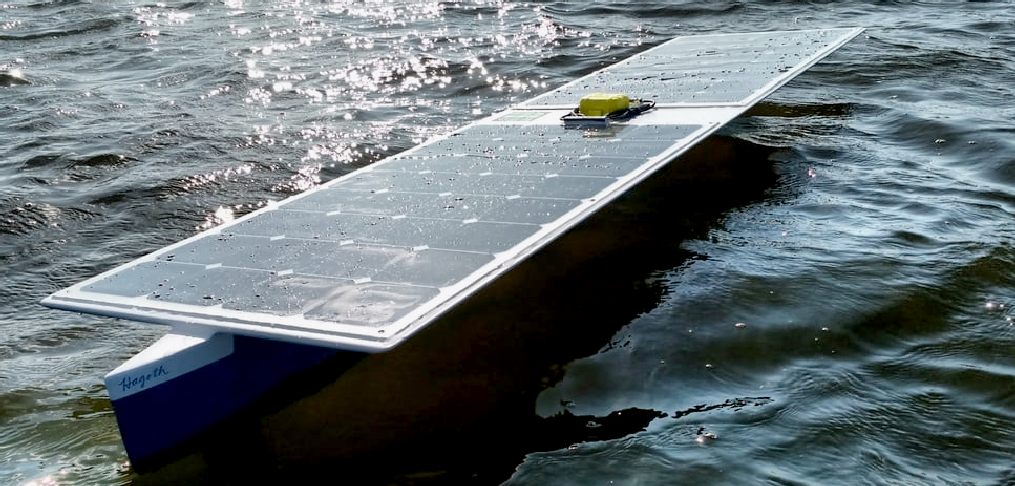
SEACHARGER - The autonomous boat
that is designed to tackle the Pacific Ocean.
NEW
ATLAS MAY 26 2016
Silicon Valley father of four Damon McMillan is hoping to launch the fruits of a two year garage project in time for Memorial Day. He's just put the finishing touches to his Seacharger boat and plans to set it off on a solo trip from the Californian coast down to Hawaii on May 30. The craft is designed to cut through the waves using only a motor powered by solar panels.
We've seen a few PV-topped seafaring rovers before, of course, but boats like the
Wave Glider and the C-Enduro used the
waves or the
wind as well as the sun to help keep them moving along. The Seacharger is designed to be the first to successfully cross an ocean on its own using solar power only.
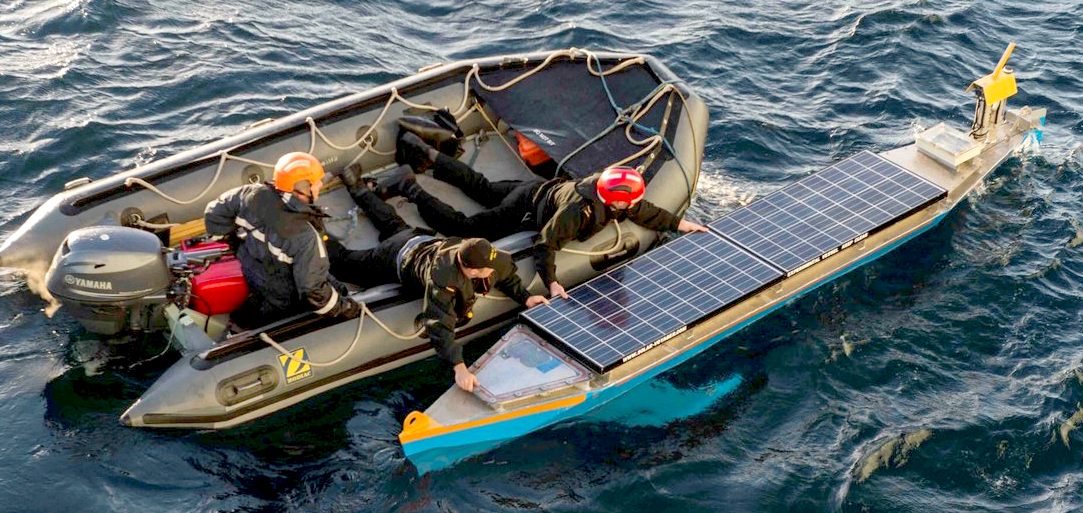
SEACHARGER'S
RESCUERS - On 1st of January 2017 , the captain and crew of the Sofrana Tourville heroically rescued Seacharger with the intention of taking the brave little robot to New Zealand.
McMillan started the Seacharger project toward the end of 2013 by gluing together and shaping over two dozen foam pieces to form a plug for a fiberglass hull mold. The hull itself is fashioned from foam covered in fiberglass, and the craft is 91 inches long and 22 inches wide (2.3 x 0.55 m). Work then began on the propulsion system.
The propeller is rotated by a brushless electric motor (the kind used for remote-controlled hobby aircraft) connected to a belt drive reduction mechanism to ensure a slow, steady spin. The hull is topped by two Renogy PV panels rated at 100-watts that each juice up a 50 cell LiFePo4 battery bank housed within a thruster pod (fashioned from a PVC pipe) suspended below the craft by
carbon fiber struts. 
The Seacharger is also home to an
Arduino-based
autopilot, GPS and satellite modem circuitry housed in a watertight enclosure positioned between the solar panels. It weighs in at 50 lb (22.7 kg) and has a cruising speed of 3 knots. McMillan reckons it can manage 3 days of travel without needing sunlight before the batteries drain, but will happily boat along indefinitely when baking in the sun's rays.
The completed boat was tested on autopilot for the first time just last month and, weather permitting (there are high winds off the Californian coast at the time of writing), it will begin its 2,000 mile (3,200 km) journey on Monday. You can track its progress via the source link below.
Fingers crossed it will fare better than the student-created Scout, which was lost on the high seas on its way to
Spain in November 2013.
By Paul Ridden 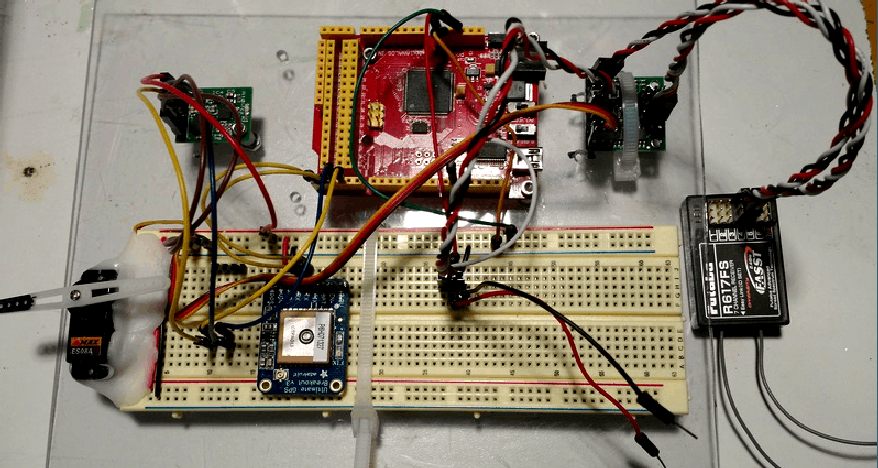
SEACHARGER
SOLAR BOAT
- SeaCharger arduino breadboard with Futaba radio receiver 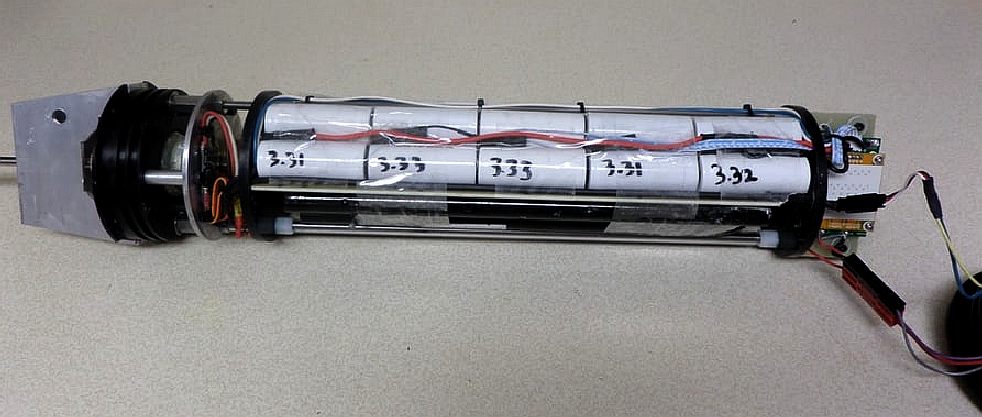
SEACHARGER
SOLAR BOAT
- Lithium battery pack in the propulsion pod that runs submerged, including the
charge controller circuit and drive motor.
.
CALIFORNIA TO HAWAII
& A BIT MORE
SeaCharger completed its voyage from California to
Hawaii on July 22,
2016. She covered a distance of 2413 miles in 41.4 days at sea at an average
speed of 58.3 miles per day at 2.43 mph, or 2.11 knots
(1.09 m/s).
SeaCharger then aimed for New Zealand and got within 300 miles before the rudder finally died.
The total distance covered before the rudder failed was 6480 nautical miles (7457 statute miles, 12,000
km). The total time at sea was 155 days.
MAKE ZINE 25 JANUARY 2017
I struggle to descend the stairs leading to the sandy beach at Half Moon Bay, California, awkwardly hefting the 60-pound solar-powered SeaCharger atop my shoulder. Amid numerous ďwhat-the-heck-is-that?!Ē stares, I perform some last-minute checks of the propeller and rudder, then wade out knee-deep and push SeaCharger as hard as I can toward the oncoming waves. Moving at walking speed, the boat makes it through the first several waves without flipping. Relieved, I make my way back onto the beach, then turn and watch my two-and-a-half-year project plodding westward, gradually disappearing in the whitecaps. A watchful bystander approaches me and says heís sorry I lost
control of my boat and that heís sure itíll wash up on the beach. I assure him that the boat is on autopilot, going exactly where itís supposed to go. ďAnd where is that?Ē ďHawaii.Ē The look on his face is priceless.
Indeed, the idea of this tiny, homemade boat surviving 2,400 miles of open ocean to reach Hawaii seems foolishly unrealistic. I know that more than anyone. With help from friends, I built the eight-foot long, foam-and-fiberglass SeaCharger in my garage ó not for money or competition, but simply as a challenge. And a challenge it was. What started out as a yearlong project turned into 30 months of mistakes, compromises, and do-overs. So for the next few hours, I spend my time worrying and fretting, glued to my phone, waiting for each telemetry report sent by SeaChargerís satellite modem. When it becomes obvious that the boat is still on track, I get in my truck and drive home.
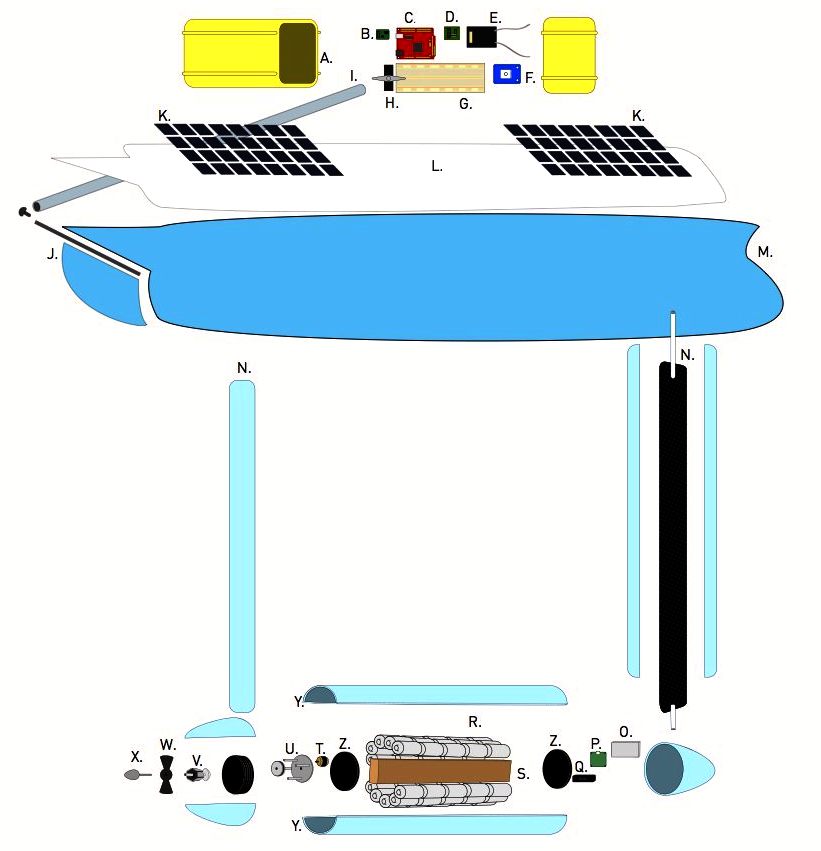
SEACHARGER
COMPONENTS: (Diagram by Hep Svadja) A: Electronics Enclosure
B: Devantech CMPS-11 tilt-compensated compass
C: Seeeduino Mega
D: Pololu Servo MUX Board
E: R/C Receiver
F: Adafruit GPS
G: Breadboard
H: Servo
I: Rudder control arm (connects to servo)
J: Rudder
K: Solar Cells
L: Boat deck
M: Hull
N: Carbon fiber shafts with embedded electronics wiring
O: Voltage Regulator
P: Battery controller and D/C regulator
Q: Data logger
R: Batteries
S: Balancing Board
T: R/C airplane brushless motor
U: 4:1 belt drive reduction using GT2 timing belt
V: Thruster
W: Propeller
X: Prop screw
Y: Keel enclosure
Z: Black delrin thruster pod endcap
TOUCH
AND GO
For the next day or two, SeaCharger appears to be doing remarkably well. Itís windy off the California coast, and I can tell from the onboard attitude sensor that SeaCharger is heeling sharply. Yet the boat keeps moving west, slowly but surely, reporting in every two hours via satellite. Even at night the boat plods on with stored solar energy in its large lithium-iron phosphate battery pack. Then, after only two days, the boat fails to send its normal update. Itís not completely unheard-of ó sometimes
satellites donít provide a strong enough signal ó but itís very rare. So I anxiously wait another two hours. Again, nothing. The boat is dead, and I know it. Itís never missed two updates in a row. I tell a friend that it must have sunk or been eaten by a shark. My friend says the
boat will be fine. I find his reassurance unreasonable but comforting. Sure enough, two hours later, SeaCharger miraculously checks in again, and I breathe a sigh of relief.
Problems occur over and over again during the next few weeks ó the motor controller stops and has to be reset, strong currents almost halt the boatís progress, a cloudy day causes the boatís batteries to run out of juice. Each time, the only information I have is that the boat has stopped moving. It has no weather sensors and minimal diagnostic sensors. Extra sensors would have been expensive and risky. Increased complexity means there are more things to break.
But without weather or other information, my imagination runs wild. I often assume one of the boatís four waterproof electrical connectors has sprung a leak. I built them out of brass plumbing fittings, added O-ring grooves using a Sherline desktop mill, and potted the electrical contacts with 3M epoxy. The entire boat is an amalgam of hobby-grade/homemade components and professional-grade ones. Using purely homemade parts might jeopardize the boatís reliability, but paying for purely professional-grade parts might jeopardize my marriage. Any time SeaCharger stumbles, I wonder if I went cheap one time too many.
One of the biggest questions is if the boatís solar panels will survive. Theyíre not the type youíd find on a house, as those canít be immersed in salt water. Instead, they are made only from laminated layers of plastic, without the typical aluminum and glass components found in other panels. If placed on a house, these thin, semi-flexible panels might not withstand tree branches falling on them, but there are no trees on the ocean. Extra marine sealant is applied to the panels where the electrical wires exit, and the panels are hard-wired to the boat instead of using connectors. Two solar panels are used for redundancy, but there is no redundancy in any of the other components on the boat, mostly to keep costs down.
SeaCharger uses off-the-shelf electronics as much as possible. The brains of the boat are an Arduino Mega, an Adafruit GPS, a satellite modem from Rock Seven, a compass from Devantech, and a battery protection/charging circuit from AA Portable Power Corp. A typical brushless motor spins the propeller and an R/C servo turns the rudder. I donít worry too much about the reliability of the electronics, but I do worry about the motor and servo. Water isnít the problem: the motor transfers torque to the propeller through a magnetic coupling, so it stays perfectly dry. And the servo has its own custom enclosure with rubber shaft seals to keep water out. But the bigger issue is the time required to get from California to Hawaii: the motor will have to run almost nonstop for over a month, while the rudder servo will have to complete 2 to 3 million cycles.
SMOOTH SAILING
In spite of my worrying, after 3 weeks at sea, the boat is not only still alive but is actually moving along at a very good clip. For the past two and half years, amid my childrenís constant cries of ďDad, when is the boat going to be done?Ē Iíve motivated myself by visualizing the moment when Iím standing somewhere in Hawaii as SeaCharger appears in the distance, comes motoring into the harbor, and I pull it triumphantly out of the
water. Now it looks like that might actually happen!
Three more weeks pass. Iím standing on the shore at Mahukona Harbor on the Big Island with my wife, parents, brother, and a reporter from the local newspaper. I catch the first glimpse of SeaChargerís solar panels flashing in the setting sun as it approaches. This moment is not as triumphant as it is surreal. This is the same SeaCharger that left California 41 days and 2,413 miles ago, but the faded paint and clinging barnacles only hint at what it must have experienced ó and survived ó to get here.
Safely ashore, SeaCharger appears to be in remarkably good shape. Iíve been asked dozens of times what I would do with SeaCharger after it made it to Hawaii, but I had never seriously considered it. Now itís time to decide. We could pack it in a giant crate and ship it home, but that option doesnít appeal to our pocketbook nor our sense of adventure. The truth is, the goal of this project was to send a solar-powered boat across an ocean. Making it from California to Hawaii was certainly an epic voyage, but it wasnít truly transoceanic. So I reprogram the boat to navigate across the Pacific towards New Zealand, a seemingly impossible 4,400 miles away, and launch it.
The California launch was cold, windy, and extremely nerve-wracking. But in Hawaii, thereís only a minor breeze blowing over a perfect white sand beach. I wade in, waist-deep, lower SeaCharger into the warm water, and it casually motors out to sea. There are no nerves or tension. I feel SeaCharger has already proven itself.
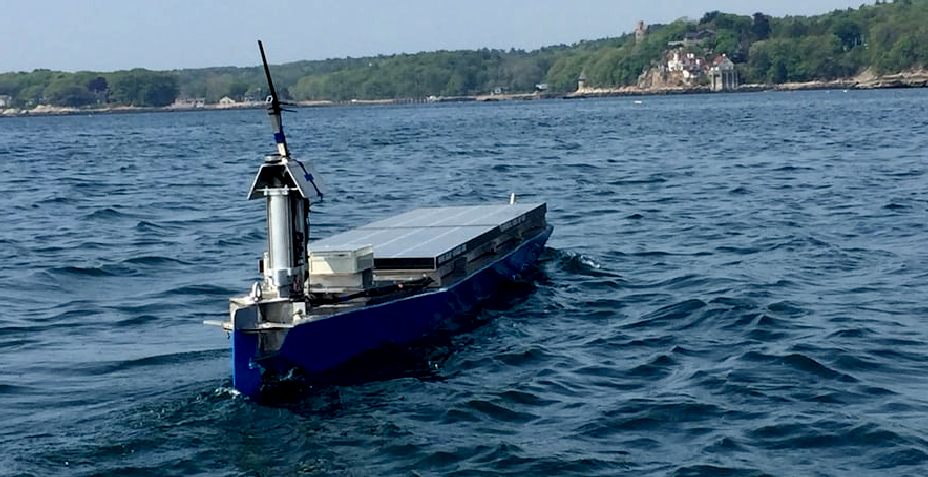
SOLAR
VOYAGER - Two hefty PV panels are low in the water so will get a dousing routinely, but should stay
clean enough for the crossing. This has not been a problem for the Autonaut.
The concept is similar to the Scout
that attempted to set the Atlantic
unmanned record in 2013.
SUPREMELY SEAWORTHY
As I write this, 90 days have passed since SeaCharger left Hawaii. Itís crossed both the equator and the International Date Line and has traveled over one quarter of the Earthís circumference. On one or two occasions it came dangerously close to running aground on a small island, thanks to a combination of my poor planning and stormy weather. Every time SeaCharger nears an island, I research that islandís geography and history. I learned that the Maori name for New Zealand is Aotearoa, or ďthe land of the long, white cloud.Ē Gee, it sure wouldíve been nice to know that before I sent my solar-powered boat there!
The Maori knew what they were talking about: there are lots of clouds around New
Zealand. And as SeaCharger makes its approach, the wind and currents conspire against it, pushing it north as it tries to make headway south. After three months at sea, the boat is dramatically slower, likely carrying a large load of barnacles. At one point I give up on New Zealand and send a command to the boatís satellite modem to turn it west in an attempt to make it to New Caledonia or Norfolk Island. But the incredibly friendly, enthusiastic New Zealanders who are preparing for SeaChargerís arrival assure me that conditions will change. Sure enough, soon the winds calm and southward progress becomes possible again.
New Zealand is only 500 miles away now. I have no idea if SeaCharger will reach the shore alive. Whatever happens, I am both supremely pleased and completely baffled that it has come this far and lasted this long.
Perhaps the greatest surprise of the entire project has been the intense interest and unfailing support from hundreds of people all over the world. I would expect the New Zealand high school science teacher who leads an autonomous boat club at his school, and the budding engineer who grilled me on the technical details at Maker Faire, to be interested in this record-breaking boat. But itís even more surprising and satisfying to have my vintage-VW-loving brother-in-law and my wifeís gardening, baking, homeschooling mom friend tracking it faithfully online. Iíve come to realize that this voyage has a universal appeal far beyond what I ever imagined when I began.
An immense thank you goes to JT Zemp, Troy Arbuckle, and Matt Stowell. Troy and Matt built the rudder actuator and helped with various electronics. JT was there from the beginning, helping with overall system architecture, fabrication, and testing.
LINKS & REFERENCE
http://www.seacharger.com/tracking.html
http://www.seacharger.com/
http://www.solar-voyager.com/
https://twitter.com/solar_voyager
http://www.seacharger.com/tracking.html
http://www.seacharger.com/
https://twitter.com/solar_voyager
http://www.solar-voyager.com/
http://makezine.com/2017/01/25/seacharger/
http://makezine.com/2016/08/22/solar-powered-autonomous-boat/
http://newatlas.com/author/paul-ridden/
http://newatlas.com/seacharger-solar-power-boat-ocean/43548/
http://newatlas.com/solar-voyager-autonomous-boat-atlantic/43738/

ACIDIFICATION
- ADRIATIC
- ARCTIC
- ATLANTIC - BALTIC
- BERING
- CARIBBEAN - CORAL - EAST
CHINA
SEA
ENGLISH CH
-
GOC - GULF
MEXICO
- INDIAN
-
IRC - MEDITERRANEAN -
NORTH SEA - PACIFIC
- PERSIAN GULF - SEA
JAPAN
STH
CHINA - PLASTIC
- PLANKTON - PLASTIC
OCEANS - SEA
LEVEL RISE - UNCLOS
- UNEP
WOC
- WWF
|






